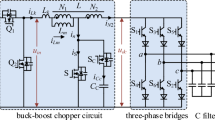Abstract
In this paper, a new control strategy for zero-current transition technique is suggested to constant voltage constant frequency sinusoidal PWM inverter. This strategy consists of a resonant arm and auxiliary switches, which are connected to a standard single-phase full-bridge voltage source inverter and also to a proportional integral voltage controller. The main and auxiliary switches can be separately controlled. The suggested strategy is able to reduce switching losses successfully, and also it does not need any snubber circuit. By using appropriate switching algorithms, the strategy can be applied to uninterruptible power supplies, photovoltaic systems and DC/AC inverters as well. In this study, not only the theoretical analysis but the simulations of the suggested strategy have been carried out effectively. From the simulation results, it has been shown that the suggested strategy yields 30% less switching losses and has better performance when compared with the hard switching strategy for the same operating condition, including the conditions of the load and the switching frequency. Eventually, the suggested control scheme verified by the simulation results proves that it can achieve low THD values in addition to less switching losses.











Similar content being viewed by others
References
Wang CM (2007) Zero-voltage-switching DC/AC inverter. IET Electr Power Appl 1:387–394
Rajaei AH, Kaboli S, Emadi A (2008) Sliding-mode control of Z-source inverter. In: 34th Annual Conference of IEEE on Industrial Electronics, Orlando, FL, pp 947–952, 10–13 Nov 2008
Chung H, Hui SYR, Tse KK (1998) Reduction of power converter EMI emission using soft switching technique. IEEE Trans Electromagn C 40:282–287
Van de Sype DM, Van den Bossche APM, Maes J, Melkebeek JA (2002) Gate-drive circuit for zero-voltage-switching half-and full-bridge converters. IEEE Trans Ind Appl 5:1380–1388
Ting NS, Aksoy I, Sahin Y (2017) ZVT-PWM DC-DC boost converter with active snubber cell. IET Power Electron 10:251–260
Jana J, Saha H, Bhattacharya KD (2017) A review of inverter topologies for single-phase grid-connected photovoltaic systems. Renew Sustain Energy Rev 72:1256–1270
Guo Z, Kurokawa F (2009) Control and PWM modulation scheme for dead-time compensation of CVCF inverters. In: 31st international telecommunications energy conference, Incheon, pp 1–6, 18–22 Oct 2009
Öztürk N (2008) Analysis of switching losses of hard and soft switching in full bridge converter. J Fac Eng Archit Gazi Univ 23:147–155
Chuang YC, Chuang HS, Ke YL (2006) Design and implementation of battery charger with zero-voltage-switching-resonant converter for photovoltaic arrays. In: Industrial and commercial power systems technical conference, Detroit, MI, pp 1–6
Hua G, Lee FC (1995) Soft-switching techniques in PWM converters. IEEE Trans Ind Electron 42:595–603
Yong L, Lee FC, Boroyevich D (2001) A three-phase soft-transition inverter with a novel control strategy for zero-current and near zero-voltage switching. IEEE Trans Power Electron 16:710–723
Bodur H, Yıldırmaz A (2017) New ZVT snubber cell for PWM-PFC boost converter. IEEE Trans Ind Electron 64:300–309
Zhang B, Zhou K, Wang D (2014) Multirate repetitive control for PWM DC/AC converters. IEEE Trans Ind Electron 61:2883–2890
Duffey CK, Stratford RP (1989) Update of harmonic standard IEEE-519: IEEE recommended practices, requirements for harmonic control in electric power systems. IEEE Trans Ind App 25:1025–1034
Singh B, Bist V (2013) Improved power quality IHQRR-BIFRED converter fed BLDC motor drive. J Power Electron 13:256–263
Zhou K, Wang D, Low KS (2000) Periodic errors elimination in CVCF PWM DC/AC converter systems: repetitive control approach. IEE Proc Control Theory Appl 147:694–700
Keliang Z, Danwei W (2002) Unified robust zero-error tracking control of CVCF PWM converters. IEEE Trans Circuits Syst I Fundam Theory Appl 49:492–501
Ye Y, Zhang B, Zhou K, Wang D, Wang Y (2007) High-performance cascade-type repetitive controller for CVCF PWM inverter: analysis and design. IET Electr Power Appl 1:112–118
Bal G, Öztürk N (2011) A novel control technique for soft switching sinusoidal PWM inverter. Electr Power Compon Syst 39:31–45
Bal G, Öztürk N, Bekiroğlu E (2009) Implementation of indirect vector control to induction motor with zero current transition inverter. In: XXII international symposium on information, communication and automation technologies ICAT 2009, Sarajevo, Bosnia and Herzegovina, pp 1–6, 29–31 Oct 2009
Zhou K, Wang D (2001) Digital repetitive learning controller for three-phase CVCF PWM inverter. IEEE Trans Ind Electron 48:820–830
Yokoyama T, Kawamura A (1994) Disturbance observer based fully digital controlled PWM inverter for CVCF operation. IEEE Trans Power Electron 9:473–480
Rech C, Pinheiro H, Grundling HA, Hey HL, Pinheiro JR (2001) Analysis and design of a repetitive predictive-PID controller for PWM inverters. In: Power electronics specialists conference, Vancouver, BC, pp 986–991, 17–21 Jun 2001
Author information
Authors and Affiliations
Corresponding author
Rights and permissions
About this article
Cite this article
Öztürk, N., Kaplan, O. & Çelik, E. Zero-current switching technique for constant voltage constant frequency sinusoidal PWM inverter. Electr Eng 100, 1147–1157 (2018). https://doi.org/10.1007/s00202-017-0577-4
Received:
Accepted:
Published:
Issue Date:
DOI: https://doi.org/10.1007/s00202-017-0577-4




